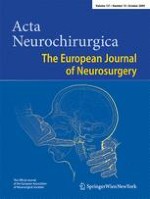01-10-2009 | Clinical Article
Antibiotic-impregnated ventriculo-peritoneal shunts in patients at high risk of infection
Published in: Acta Neurochirurgica | Issue 10/2009
Login to get accessAbstract
Purpose
To determine the efficacy of antibiotic impregnated shunts (AIS) in reducing shunt infections in a population at high risk of shunt infection.
Methods
From October 2005 to October 2007, patients at high risk of infection (severely disabled, not able to take care of themselves, frequent nosocomial infections) were selected from the 198 adults who underwent shunt placement.
Results
Eighteen adults were identified (mean age 61.8 years). Six patients had AISs, and 12 patients had non-AISs. Groups did not differ in age, sex, type of hydrocephalus or hospital stay before shunting. Shunt infection occurred in 7/12 cases of the non-AIS group (58.3%) versus no infections in the AIS group. In six of seven cases, infection occurred within the first 6 months after surgery. A prevalence of S. epidermidis was detected.
Conclusions
We believe that in these patients AIS could be effective. Larger, prospective studies are needed in order to definitely address this issue.





